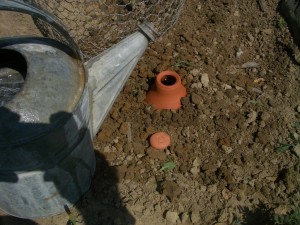Oh Yeah? or Oh No?
That is the question. Well, the first question is really, What the heck is an olla? Well, I wasn’t even sure myself until I did a little digging. (pun intended but you won’t get it yet until we dig a little deeper) OK; I was at a local arts festival and my friend April came to my booth and asked me if I could make ollas. In past posts you’ll remember noting I am the potter that always says, “sure”, and then pauses and says, aaaaaa, “what’s an olla?” She proceeded to tell me about these pots that are buried in the ground and provide water to the roots of plants. OK, now she really has my attention. POTS and GARDENING, that’s two of my passions and what these posts are all about. After doing a little more research, I found this idea has been around for quite awhile, with history going back to the Spanish bringing the idea to the indigenous people of the Americas. I knew that earthenware pots would seep very, very slowly if liquid was left in them, but have read that the Earth, or dry soil would actually draw the water out faster. Makes sense. So I told April we would go on an olla journey together and document what happens in both our gardens with a few test ollas.
Here are the brave ollas, lined up for their group shot before they undertake their underground mission. There are no holes in the pots, other than the one to pour the water in. I made little clay caps to fit over the holes to slow down evaporation through the top, and to keep mice from using the ollas for wild nighttime skinny dipping parties. The research I did explained how people would cover the holes with rocks or shells. In the past few weeks, deer have knocked the plug off at night, perhaps smelling the cool liquid in the pots. We, I forgot to mention, are actually in a severe drought situation, making this a great year to test the ollas validity. 
Here is an image April sent me of her olla buried next to her peas. She lives about 20 miles from me and has completely different soil makeup. Her garden is very sandy and ours is very heavy clay soil; so this will be a good test for both soil types. 
Here is one of April’s ollas waving goodbye. The pots can be buried right up to the water filler hole. Every few days, just check and fill. Pretty easy so far. I was able to have a good test offered up for my olla placement by our wonderful, plant eating deer friends, who live in the nearby woods.
Behind the olla, you can barely see what was a beautiful, lush, leafy green pepper plant before the deer ate it down to a green stick. Also, there is one a little bit further east that was eaten too. So, the olla goes by one green stick and the other green stick does not get water. Pretty good test I think. These images were taken a few weeks ago and we still have not had any rain. It is truly getting very sad for all the farmers and all critters looking for water. It’s hard to be upset at the deer for knocking the plugs off; I just wonder if they are really trying to stick their tongues in to the ollas to get water?
Here is my olla up to its neck in its mission. I have to say, the green stick has leafed out and is looking better. I will post images of both plants in a few weeks and let you decide if ollas are Oh Yeah!!! or Oh No! In either case, help us all in this part of the country by saying a little prayer for rain.

Did you make those Ollas? Do you sell them? If so, would you ship them to an APO address? (need to pack them VERY well)
Hi Annie,
Yes, I did make the ollas and I do sell them for $12 each. I have never shipped to an APO address; I use UPS, so I don’t think that would be a problem. I charge what UPS charges me. The problem with shipping these is the same thing that makes them good, their ‘bulbosity’! To get more then one in a box, wrapped in bubble wrap gets to be a challenge, and the box needed then gets to be pretty big fast, which then causes shipping to go up. I would actually recommend finding a local potter to make some for you. If you showed them the picture, they should be able to reproduce; but if you can’t, I would be happy to work with you. Thanks! and happy gardening. Tom